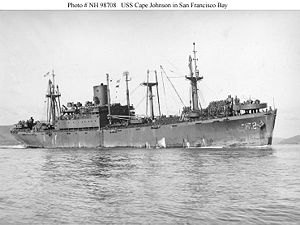
| |
| History | |
|---|---|
| Name | USS Cape Johnson |
| Builder | Consolidated Steel Corporation, Wilmington, Los Angeles |
| Launched | 20 February 1943 |
| Commissioned | 1 June 1944 |
| Decommissioned | 25 July 1946 |
| Honors and awards | 2 battle stars (World War II) |
| Fate |
|
| General characteristics | |
| Type | Type C1-B cargo ship |
| Displacement | 5,668 long tons (5,759 t) |
| Length | 417 ft 9 in (127.33 m) |
| Beam | 60 ft (18 m) |
| Draft | 22 ft 3 in (6.78 m) |
| Propulsion | Steam turbine, single propeller, 4,000 hp (2,983 kW) |
| Speed | 15 knots (28 km/h; 17 mph) |
| Capacity | 72,168 cubic feet |
| Troops | 1,288 |
| Complement | 371 |
| Armament |
|
USS Cape Johnson (AP-172), was a United States Navy troop transport ship that was used in the South Pacific during World War II. The ship was named for a cape off the coast of Washington state.
Service history
Construction and commissioning, 1943–1944
Cape Johnson, a 5,668-ton Maritime Commission C1-B type cargo ship, was built at Wilmington, Los Angeles. She was launched on 20 February 1943 by Consolidated Steel Corporation, Ltd., Wilmington, Los Angeles, under a Maritime Commission contract and sponsored by Mrs. A. C. Steward. The ship was converted to a troop transport by Los Angeles Shipbuilding and Dry Dock Co. capable of carrying 1,575 troops. Cape Johnson was acquired by the Navy under bareboat charter and commissioned on 1 June 1944 and then reported to the Pacific Fleet.
1944–1946
Cape Johnson was initially used to redistribute Army and Marine forces between the Marianas and bases in the South Pacific. In November 1944 she arrived with a supply echelon off the assault areas at Leyte in the Philippines and then landed her troops at Samar. In January 1945, Cape Johnson landed troops in Lingayen Gulf during the initial assault on Luzon Island. In mid-February she arrived off Iwo Jima with Marine Corps troops and cargo, which she put ashore as needed through the end of March. The transport then returned to San Francisco and carried troops from there to Manila.
With the bitter fighting on the island over, Cape Johnson embarked men of the 5th Marines, whom she carried to Pearl Harbor. Sailing on to San Francisco, where she arrived on 22 April 1945, Cape Johnson transported troops from the west coast to Manila, and on 16 August cleared the Philippines for Pearl Harbor. With occupation troops loaded there, the transport arrived at Wakayama, Honshū, Japan on 27 September, and then began transpacific crossings returning servicemen to the States. She was decommissioned 25 July 1946 and returned to her former owner the next day. The ship was sold for scrapping, on 10 June 1963, to Zidell Explorations, Inc., Portland, Oregon.
Harry Hess
The American geologist Harry Hess commanded the USS Cape Johnson during her commission. In addition to his Naval duties, Hess carefully tracked his travel routes to Pacific Ocean landings on the Marianas, Philippines, and Iwo Jima, continuously using his ship's echo sounder. This unplanned wartime scientific surveying enabled Hess to collect ocean floor profiles across the North Pacific Ocean, resulting in the discovery of flat-topped submarine volcanoes, which he termed guyots. This information led to many discoveries which helped to form the basis of the theory of plate tectonics.
Awards
Cape Johnson received two battle stars for World War II service.
References
- ^ Naval History And Heritage Command. "Cape Johnson". Dictionary of American Naval Fighting Ships. Naval History And Heritage Command. Retrieved 28 December 2020.
- Charles, Roland W. (1947). Troopships of World War II (PDF). Washington: The Army Transportation Association. p. 80. LCCN 47004779. Retrieved 28 December 2020.
- O'Hara, Kieran D. (2018). A Brief History of Geology. Cambridge, United Kingdom & New York, NY: Cambridge University Press. p. 141. ISBN 9781107176188. LCCN 2017051822. Retrieved 28 December 2020.
 This article incorporates text from the public domain Dictionary of American Naval Fighting Ships.
This article incorporates text from the public domain Dictionary of American Naval Fighting Ships.
External links
- Photo gallery of USS Cape Johnson at NavSource Naval History